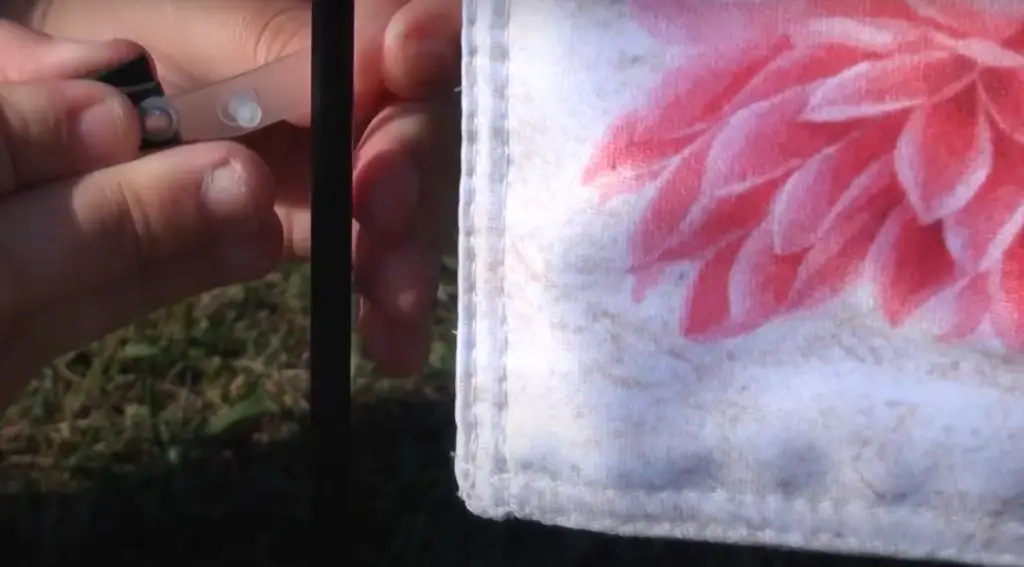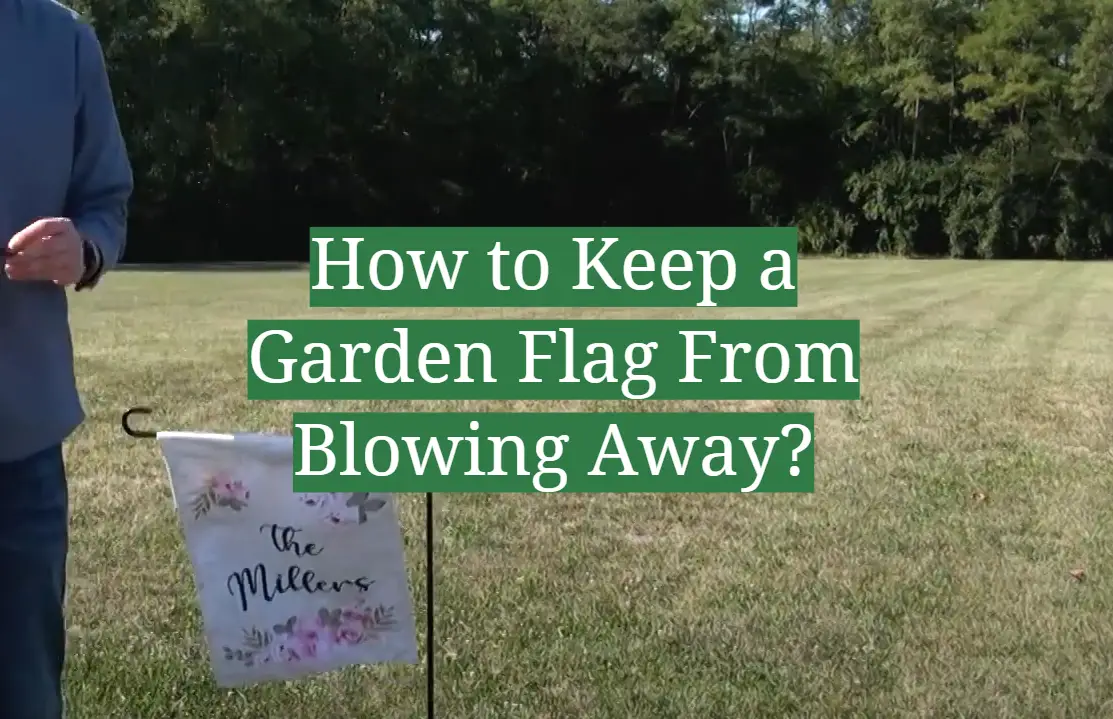It’s no secret that garden flags can be a beautiful addition to any home. They add personality and charm, and can really make your garden stand out. However, one of the biggest challenges with garden flags is making sure they stay in place. If you don’t take steps to secure them, they can easily blow away in the wind. In this blog post, we will discuss some tips on how to keep your garden flag from blowing away!
Why Put a Flag in Your Garden?
Garden flags are a popular way to show your personality and style while welcoming visitors to your home. A flag also adds color and interest to your garden, whether it’s placed in the front yard or backyard. But what happens when windy weather blows your beloved flag away? [1]
Tips for Keeping a Garden Flag from Flying Away
Have a Solid Foundation
The first step in preventing your garden flag from blowing away is to ensure that it has a solid foundation. This means that the flag should be securely attached to a pole or stand.

You can use zip ties, screws, or even hot glue to attach the flag to the pole. Just make sure that whatever method you use is strong enough to hold up in windy conditions. [2]
Choose the Right Flag Poles
Choosing the appropriate flagpole is the second step toward preventing your garden flag from flying away. There are a variety of flagpoles available on the market, but not all of them are created equal. Some flagpoles are made specifically for garden flags, while others are made for larger flags. Be sure to select a flagpole that is appropriate for the size and weight of your garden flag.

In addition, be sure to select a flagpole that is made out of durable materials. Some materials, such as aluminum or steel, will stand up better to windy conditions than others.
Use Soft Surface Stakes
If you’re staking your garden flag on soft ground, you’ll want to use a soft surface stake.
They also have a wide base that helps keep the flag from blowing away in strong winds. [3]
Securely Fasten Tie Hanging Garden Flags
Tying garden flags down is the simplest and most popular method to keep them from flying away. This can be done by tying the flag to a post, stake, or another object in your yard. You can also use bungee cords or zip ties to secure the flag to a solid object.
Use Heavy-Duty Garden Flag Stands
Another option for keeping garden flags in place is to use a heavy-duty stand. There are many different types of stands available, so you should be able to find one that meets your needs. The flags on a number of stands are weighted to keep them from blowing away, while others have spikes that may be driven into the ground.
Add Sand or Water to Garden Flag Stands
If your garden flag stand is too lightweight, add some sand or water to the base. This will help keep it from blowing away in the wind. You can also use rocks or pebbles instead of sand or water. Just make sure whatever you use is heavy enough to weigh down the stand.
Flag Etiquettes To Consider
When flying a flag on your property, there are certain etiquettes to consider. The United States Flag Code is a set of guidelines that should be followed when displaying and handling the American flag. When it comes to garden flags, the code doesn’t specifically mention them. However, there are still some general principles that you should follow.
First, make sure the flag is in good condition. It shouldn’t be tattered, torn, or faded. If it is, it’s time to replace it.
Second, the flag should only be flown during daylight hours. If you’re going to keep it up after dark, be sure to put a light on it so that it’s visible.

Third, when flying multiple flags, the American flag should always be at the top. Garden flags are typically smaller than traditional flags, so this may not be an issue. But if you’re flying both types of flags, make sure the American flag is on top.
Finally, take down your garden flag during inclement weather conditions.
By following these simple tips, you can keep your garden flag flying all season long! [4]
Comparing Methods to Keep a Garden Flag From Blowing Away
When decorating our gardens with beautiful flags, one common problem we face is keeping them from blowing away in strong winds. Here, we compare various methods to secure garden flags and prevent them from flying away.
| Method | Effectiveness | Cost | Difficulty |
|---|---|---|---|
| Using Flag Stands | High | Medium | Low |
| Weighted Flag Poles | High | Low | Low |
| Velcro Strips | Medium | Low | Low |
| Rubber Bands | Low | Low | Low |
| Wind Clips | High | Medium | Low |
| Bungee Cords | High | Low | Medium |
Explanation of the table:
- Using Flag Stands: This method involves placing the garden flag on a stand that keeps it firmly in place. It is highly effective, moderately priced, and easy to implement.
- Weighted Flag Poles: Weighted flag poles provide stability by using a heavy base to prevent the flag from blowing away. They are highly effective, cost-effective, and easy to use.
- Velcro Strips: Velcro strips can be used to secure the flag to a fixed object, but their effectiveness is moderate, and they are relatively inexpensive and easy to use.
- Rubber Bands: Wrapping rubber bands around the flagpole and flag may offer some security, but it has limited effectiveness and is a low-cost and easy solution.
- Wind Clips: Wind clips are designed to grip the flag and the pole, providing excellent security. They are highly effective and moderately priced, with easy installation.
- Bungee Cords: Bungee cords can be used to secure the flag, but they might require more effort to set up compared to other methods. They are highly effective and relatively low-cost.
Consider the effectiveness, cost, and ease of implementation to choose the most suitable method for keeping your garden flag from blowing away in various weather conditions.
FAQ
What’s the best way to keep a garden flag from flipping?
There are a few things you can do to prevent your garden flag from flipping:
- Use a heavier weight fabric for your garden flag. A heavier weight fabric will help keep the wind from blowing your flag around as much.
- Add some extra weight to the bottom of your garden flag. This will help keep it from blowing away in the wind.
- Make sure that the garden flag is properly secured to the flagpole. If it’s not secure, it can easily blow away in even a moderate breeze.
You can assist guarantee that your garden flag remains in place and doesn’t blow away by using these guidelines.
What is a flag stopper, and how do you use it?
A flag stopper is a gadget that aids in preventing your garden flag from blowing away. It’s placed at the end of the flagpole, and it has a weight that keeps the flag from blowing away in the wind.
You can use a flag stopper with any type of garden flag, and it’s easy to install. Simply screw the flag stopper onto the end of the flagpole, and then place your garden flag on top of it. The weight will keep the flag from blowing away, even in strong winds.
What is the simplest method to make a garden flag?
If you want to make a garden flag, the simplest method is to purchase a kit that includes everything you need. These kits can be found at most craft stores, and they usually come with a pattern, fabric, and instructions.
Another option is to purchase a pre-made garden flag. These flags are already made, and you simply have to put them on the flagpole. This is the easiest way to get a garden flag, but it’s also the most expensive.
You can also make your own garden flag by following these steps:
- Choose a design or pattern for your garden flag. There are many different designs available online or in craft stores.
- Cut the fabric to the correct size using scissors or a rotary cutter.
- Sew the fabric together, following the pattern or design.
- Attach the garden flag to the flagpole using ties, clips, or Velcro.
Making your own garden flag is a great way to personalize it and make it unique. It’s also less expensive than purchasing a pre-made flag.
What is the proper order to hang flags?
The United States Flag should be at the center and the highest point of the group, with state and local flags below it. Flags of other nations should be at the same level as the US flag. When there are multiple flags on one pole, they should be evenly spaced.
What is the proper procedure for using an anti-wind clip?
If you live in an area that is prone to high winds, you may want to consider using an anti-wind clip. Anti-wind clips are designed to keep your garden flag from blowing away. They work by clipping onto the flagpole and holding the flag in place.
To use an anti-wind clip, simply attach it to the flagpole near the top of the pole. Then, run the clip through the loop on the back of the garden flag. The clip will hold the flag in place and keep it from blowing away in high winds. You can find anti-wind clips at most flag stores or online.
How do you attach an American flag to a garden banner?
You can attach an American flag to a garden banner in the same way that you would attach any other type of flag. First, find the top of the pole and mark it with a piece of tape. Then, take the flag and thread it through the loop on the back of the garden banner. Once the flag is in place, you can use a clip to secure it to the pole.
What is the most common material used to make garden flags?
The most common material used to make garden flags is nylon. Nylon is a durable fabric that can withstand the elements. It is also resistant to fading, so your flag will continue to look bright and vibrant for years to come.
What are some tips for displaying a garden flag?
Some tips for displaying a garden flag include:
- Choose a location that is visible from the street.
- Make sure the flagpole is securely in place.
- Attach the flag to the pole using a clip or other type of fastener.
- In windy conditions, use an anti-wind clip to keep the flag from blowing away.
You can be confident that your garden flag will be properly and safely displayed if you follow these pointers.
How can I anchor a garden flag in the ground?
To anchor a garden flag in the ground, you can use garden flag stands or stakes specifically designed for this purpose. Insert the stand or stake into the ground, then slide the flag’s sleeve over it, ensuring a secure and stable display.
Are there any alternatives to using a garden flag stand?
Yes, if you don’t have a garden flag stand, you can use heavy objects like decorative rocks or sandbags to weigh down the flag. Place these objects at the bottom of the flagpole or directly on the flag’s bottom edge to prevent it from blowing away.
How can I prevent a garden flag from tangling around the pole?
To prevent a garden flag from tangling around the pole, make sure to untwist the flag regularly. A flag with a swivel clip or a rotating pole can also help reduce tangling.
What should I do if my garden flag gets wet?
If your garden flag gets wet, take it down and allow it to dry completely before rehanging it. A wet flag is more prone to damage and may not withstand strong winds as effectively.
Can I use adhesive products to secure my garden flag?
Using adhesive products directly on your garden flag may cause damage. Instead, consider using adhesive hooks or clips on a stable surface like a wall or post to hang the flag securely.
What kind of fabric is suitable for garden flags?
Polyester is a common material used for garden flags due to its durability and resistance to fading. It is lightweight and allows the flag to flutter in the wind while maintaining its vibrant colors.
Can I display a garden flag indoors?
Yes, you can display a garden flag indoors. Consider using a decorative flagpole or hanging it on a wall to add a touch of seasonal or festive flair to your interior decor.
How can I store a garden flag when not in use?
To store a garden flag, make sure it is clean and completely dry. Fold it neatly and place it in a sealed plastic bag or a container to protect it from dust and humidity until you’re ready to display it again.
Can I customize my garden flag to make it more wind-resistant?
Yes, you can reinforce your garden flag by sewing extra grommets or fabric strips to the corners. These additions will provide additional support and stability, making it more resistant to strong winds.
Are there any specific care tips to prolong the life of my garden flag?
To extend the life of your garden flag, avoid leaving it outside during severe weather conditions. Regularly check for wear and tear, and hand wash the flag with mild detergent when necessary. Store it properly when not in use to protect it from damage.
Useful Video: Garden Flag – How to Setup
Conclusion
So, there you have it! A few simple tips to help keep your garden flag from blowing away. By following these tips, you can enjoy your beautiful flag all season long – without having to chase it down the street! Do you have any other tips for keeping garden flags in place? Share them with us in the comments below.
Happy flagging!
References:
- http://www.chinaflag.com/new/Effective-Use-and-Placement-of-Garden-Flags.html
- https://www.flagsrus.org/blogs/flagsrus-blog/glorious-garden-flags
- https://blog.flagwix.com/how-to-keep-garden-flags-from-blowing-away/
- https://www.military.com/flag-day/flag-ettiquette-dos-and-donts.html










Leave a Reply
View Comments